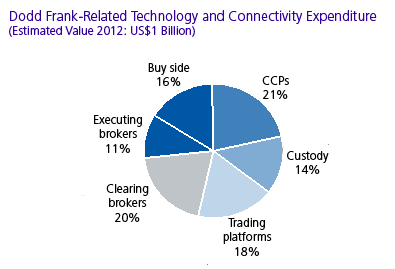OTC Derivatives Clearing and the Buy Side in the US: Rough Ride Ahead
Abstract
The overhauling of the OTC derivatives market in the form of the Dodd-Frank Act (DFA) has brought about a sea change in the clearing environment. The legislation is expected to ensure greater transparency and accountability in the system. However, the move from bilateral to counterparty clearing will require a great deal of resources on the part of market participants, especially the buy side.
In a new report, OTC Derivatives Clearing and the Buy Side in the US: Rough Ride Ahead, Celent looks at the impact of the DFA on the US OTC derivatives market. It is quite possible that the move to clearing is going to impact buy side participants more than the sell side. The new changes require an overhaul of trading platforms and connectivity. With the market volatility and the slowdown in the economy reducing their capacity to bring about improvements in their infrastructure, many of the smaller firms might struggle to meet their OTC derivatives trading requirements.
As expected, a lot of the spending will be counterparty clearing (CCP) organizations and clearing brokers establishing connectivity afresh for large-scale OTC derivatives clearing. Trading platforms and custody providers are also expected to have significant expenditure. However, the executing brokers already have most of the connectivity in place. Importantly, the buy side will also have to incur costs to establish connectivity to executing and clearing brokers, and to the CCPs. But we expect that the formation of superaggregators to combine liquidity across swap execution facilities, and initiatives by brokers to ensure overall connectivity for the buy side will help reduce costs for the latter to some extent.

“The Dodd-Frank Act is going to dramatically alter the OTC derivatives markets,” says Anshuman Jaswal, Celent Senior Analyst and author of the report. “As key participants, it is important that buy side firms are able to evolve and establish the infrastructure required to operate in the new regulatory environment.”
This report looks at the changes from the point of view of the buy side. We begin by looking at the expected trends in the OTC derivatives markets and the main changes that would be brought about by the move from a predominantly bilateral model to a CCP model. This is followed by a look at the implications for the buy side of the various changes such as the impact on collateral management, margins, reporting requirements, and so on. We also look at the possible problems or issues that could arise from the regulation. Finally, we look at the financial implications and some of the expected developments from the rise in counterparty clearing.

